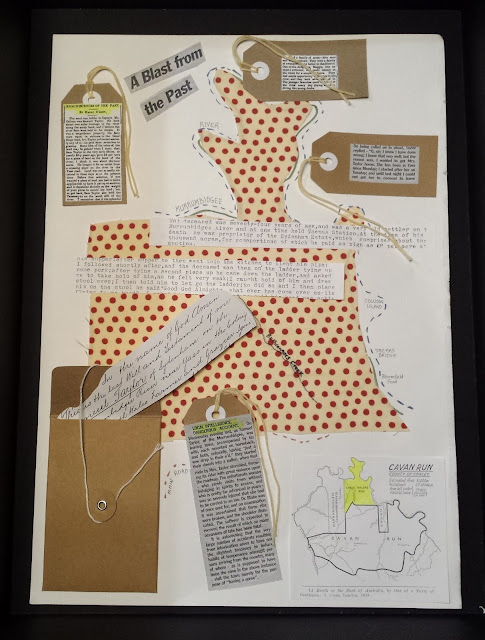Taemas
 |
| Annotated map of Taemas |
This blog post will be a bit waffly because I am fast running out of time to think clearly and make sensible well considered posts. Please forgive me.
Recently, for another University of Tasmania course called Place, Image, Object we had to make an annotated map of a place that was significant to us or our family history, bringing together subjective and objective elements. What an agonizing but fruitful exercise it was. I chose to do a map showing some of my ancestor's land near Yass and Canberra where I grew up. My ancestor was Samuel Taylor.
Here is my reflection on the task.
I created several annotated maps in the process of creating the final annotated map for my ancestor, Samuel Taylor. At first I wanted to show how place names can be duplicated in different areas. For example. George Willmore originally called Arana Hills, the suburb where I work in Queensland, after Camden Park – a place familiar to him from New South Wales. I work in Cobbity Crescent, off Narellan Street in Arana Hills Queensland. Samuel Taylor was married at Cobbitty near Narellan in NSW. I felt like my ancestor was calling to me, wanting me to tell his story. I decided to forget about where I was and focus instead on where he was at the time.
I had recently received a map from the Yass Historical Society showing Sam Taylor’s run. I traced over it several times all the while I developed great respect for map-makers with legible writing and a steady hand. My faltering efforts led me to create a digital map instead. I exchanged one set of problems for another – how best to label in Google Maps? What sequence for annotations? I chose Alphabetical and put the events in chronological order. As I re-traced the map several times, I saw more landmarks that connected with the newspaper stories I had collected over the years. The digital result still didn’t feel right. So I decided to play with collage because I am a patch worker and a hoarder at heart. It seemed right in the end. I know I will never be able to tell the whole story – just scraps.
You can check out my digital annotated map here.
And because I said this would be a meandering post, here is a picture of my daughter and me with my first completed patchwork/quilting project. See all the mess behind us? That's what happens when you do family history...you have been warned!
PS If you can get hold of the Patchwork Prisoners: the Rajah Quilt and the women who made it by Trudy Cowley and Dianne Snowden published in 2013, it is a fascinating read about 180 convict women transported to Tasmania in 1841.





Comments
The Place, Image, Object assignment was definitely a challenge! Well done on your patchwork theme - my approach also. It would be interesting to know how some of the other students tackled the challenge.
The patchwork quilt looks great.
Vicki